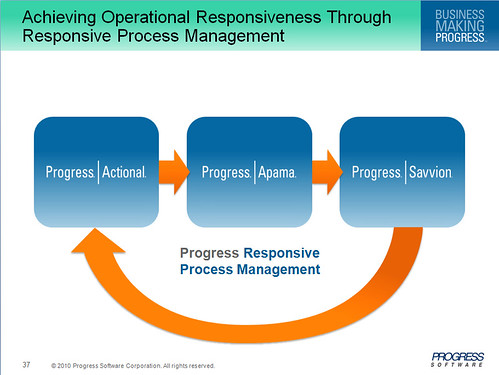I just found the last of my Progress analyst day notes from last week, scrawled in a paper notebook (which is why I usually write directly to keyboard at conferences). These were from one-on-one meetings that I had with John Bates and Dr. Ketabchi after the end of the formal presentations, where I had a chance to ask about product directions.
It’s probably good to do some writing after the fact, when I’ve had time to reflect a bit, review the presentation slides, and read posts by other attendees such as John Rymer [link fixed], who sums up Progress’ mission, customer case studies and product positioning. I particularly like his description of the two new suites that Progress is offering:
Enterprise Business Solutions tracks existing transactions and services interactions to discover and verify implicit business processes, defines, senses, and responds to real-time events, automates business process flows, and provides SOA infrastructure. Core to this business unit is a new suite that brings together Progress Actional, Apama, and newly acquired Savvion. Think of the new Responsive Process Management Suite as BPM and transactional systems wrapped in real-time event management.
Enterprise Data Services maps primary information sources into a new real-time model managed by DataXtend Semantic Integrator, including integration, aggregation, data delivery, and ultimately, analysis.
To sum up my discussions with Bates and Ketabchi (these were separate, but covered related topics, so I’ve combined them) on what’s happening with the products, particularly the integration of Savvion into the Responsive Process Management suite:
- The first version of the Control Tower monitoring application is ready, or nearly so. This is based on the Savvion process monitoring portal (which already allowed for external data sources), and constitutes the primary piece of integration between the products.
- The existing event-handling structure in Savvion will be used to feed events from Apama. Although there will be some tightening of this integration, there are no major changes required to make this happen.
- Currently, the modeling for CEP (Apama) and BPM (Savvion) are separate tools. However, they are both Eclipse-based, so it’s likely that they will be combined in some way and given a consistent look and feel, even if only as separate tabs within the same modeling environment. Since they both have business-facing perspectives using graphical models, this makes sense.
- Savvion’s current event processing capabilities – the only overlap in the Savvion and Progress product portfolios prior to the acquisition – will eventually be replaced by Apama, which will have an impact on Savvion customers who use that functionality. There is no plan for an immediate rip-and-replace, and the Savvion EP will be supported for some time, but customers should start thinking about migration.
I asked about runtime collaboration within the products, but was not left with a clear picture of the future for Progress products here. Currently, Apama supports some threshold type of changes, and Savvion allows reassigning a task to another user but not changing the process model, which seems to represent a bare minimum in this emerging functional requirement.
You can find all of my coverage of the Progress Software Analyst Day here.

